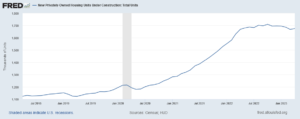May 17, 2023
Many people (including me) have been surprised by how little impact the Fed’s rate hikes seem to have had in slowing the economy to date. A big part of that story is that the housing sector still seems relatively strong, with employment in residential construction still above the level it was at when the Fed began hiking rates. Housing is the most interest-sensitive sector of the economy, so it is surprising that construction employment is not taking a hit.
The story here is pretty much unique to the pandemic recovery. Housing starts have in fact plunged. They are down by more than 20 percent from their level in March of 2022 when the Fed first began hiking rates.
However, units under construction is actually slightly higher than it was in March of 2022. Here’s the picture.

The reason is that the supply chain problems associated with the pandemic and the reopening prevented many builders from completing homes. As a result, builders are still working through a backlog of unfinished homes. Eventually, they will be able to reduce this backlog and we will see a falloff in employment in the sector, but we have not yet.
This is also good news for the other side of the story. With many homes still under construction, we will see many more homes being completed over the course of the year, which should mean downward pressure on prices and rents.
It is also worth mentioning that the Census Bureau measure of starts, units under construction, and completions only counts homes started from scratch. The units being converted from commercial to residential will not be picked up in this series. With some luck and good policy, we will see lots of these.







Comments